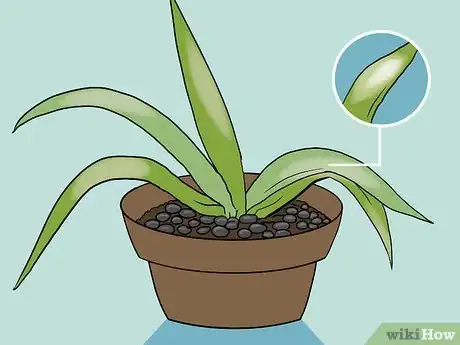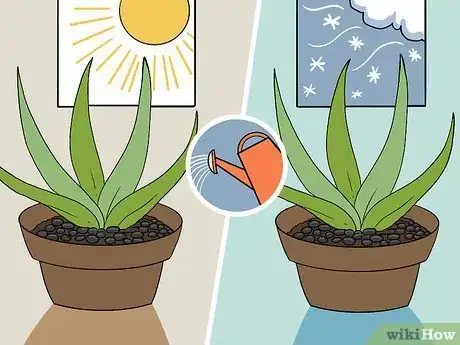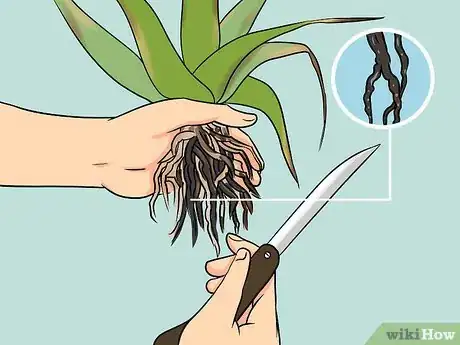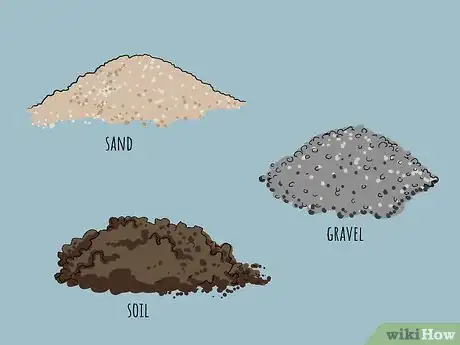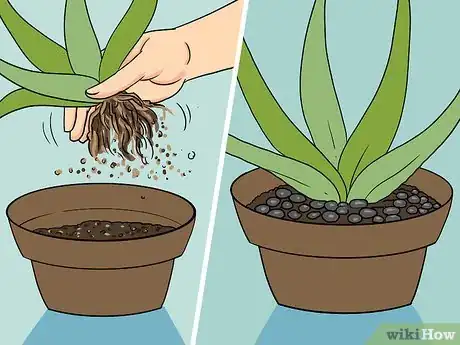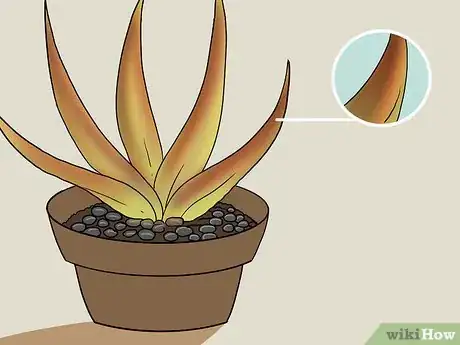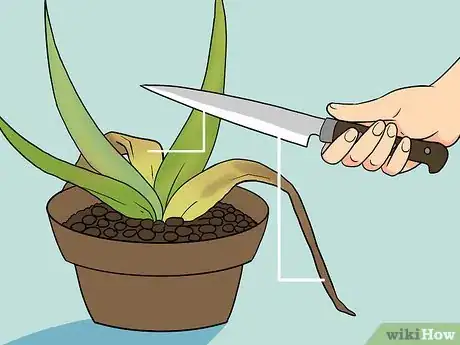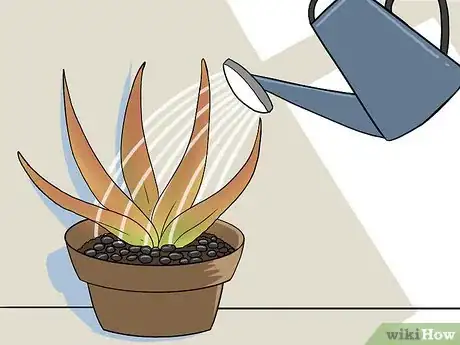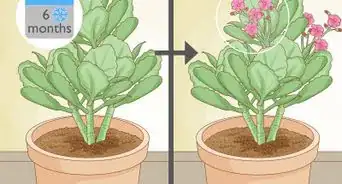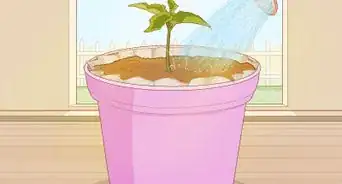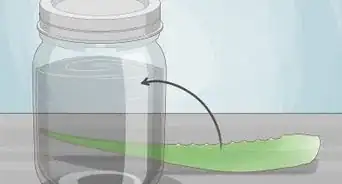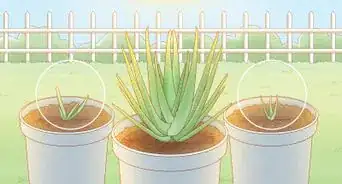This article was co-authored by Andrew Carberry, MPH. Andrew Carberry is a Food Systems Expert and the Senior Program Associate at the Wallace Centere at Winrock International in Little Rock, Arkansas. He has worked in food systems since 2008 and has experience working on farm-to-school projects, food safety programs, and working with local and state coalitions in Arkansas. He is a graduate of the College of William and Mary and holds a Masters degree in public health and nutrition from the University of Tennessee.
There are 13 references cited in this article, which can be found at the bottom of the page.
wikiHow marks an article as reader-approved once it receives enough positive feedback. This article received 68 testimonials and 92% of readers who voted found it helpful, earning it our reader-approved status.
This article has been viewed 2,185,544 times.
When your Aloe vera plant starts drooping, getting mushy leaves, or turning yellow and brown, it’s time to change up your plant care regimen. Overwatering, root rot, and sunburn are the most common reasons your Aloe might start to wilt or die. If your Aloe vera plant looks a little under the weather, don’t lose hope! We'll give you the essential knowledge you need to diagnose your plant's problem and save your Aloe vera.
Steps
Fixing Overwatering and Underwatering
-
1Examine the leaves. As a succulent, Aloe vera plants store water in their leaves. If the leaves are yellow, brown, or swollen, you’re likely dealing with overwatering. If you notice the leaves are puckering, dropping off, or are becoming almost transparent, your plant likely needs water.[1]
-
2Check the soil moisture. You can tell if your Aloe vera plant needs to be watered by pressing your index finger a few inches down into the soil. If the soil is dry, your plant needs water. Aloe vera plants are succulents and do not need to be watered often. Overwatering can kill your plant![3]
- If you keep your plant outside, watering every two weeks should be sufficient.
- If you keep your plant inside, water it every three to four weeks.
Advertisement -
3
-
4Modify watering according to the season. Aloe vera plants need more water in the warmer months, but less in the cooler months. Water less often in fall and winter, especially if your plant lives in a cool space.[6]
Repotting Due to Root Rot
-
1Remove the Aloe vera plant from its current pot. One of the typical reasons for Aloe vera plant death is root rot. If you see mushy brown leaves but don’t suspect overwatering, you need to take the plant out of its pot.[7]
- Loosely hold the base of the plant and the bottom of your pot. Tip the pot upside down, and continue holding the plant with your other hand. Hit the bottom of the pot with your hand or knock it against a table ledge (or other hard surface).
- Depending on the size of your plant, you may need another person to help you. One person should hold the plant base with both hands, while the other person tips the pot upside down and hits the bottom. Jostle the pot back and forth until the plant comes loose.
- If you still have trouble removing your plant with two sets of hands, run a trowel or knife around the interior of the pot and try releasing it again, or push some of the soil out through the drainage holes in the bottom of the pot.
- If your plant still does not come out of the pot, you may need to break your pot.
- While releasing the Aloe vera plant from its pot, hold (don’t pull) the plant gently. Hitting the bottom of the pot will keep your roots intact, and gravity will push the plant downward.
-
2Remove unhealthy roots with a sharp, sterilized knife. Examine the roots and determine how many of them are still healthy. Mushy roots are characteristic of root rot. Any roots that aren’t black or mushy are good and can be kept.[8]
- If you see a lot of healthy roots and only a section of dead or mushy roots, you can likely save your plant without too much trouble.
- If you notice that the majority of your plant has damaged roots, it will take a little more effort to save the plant, and it may be beyond saving. In this case, you can try to save the plant by removing the largest leaves (with a knife). Cut away about half of the plant. This method is risky. However, with fewer leaves to nourish, the small amount of undamaged roots can better direct nutrients throughout the plant.[9]
-
3Choose a pot that is one-third larger than the root system. Any excess soil will hold water and could cause root rot in the future, so a smaller pot is better than a larger one.[10]
- The roots of Aloe vera plants grow horizontally, rather than vertically. [11] Aloe vera plants can also become quite heavy, and the weight of the plant can cause a narrow pot to tip over. Thus, select a wide pot, rather than a deep or narrow pot.[12]
- The pot you choose should also have plenty of drainage holes on the bottom so that excess water does not sit in the soil.[13]
- A plastic pot is best if you live in a dryer climate, while a pot made from terracotta or clay is best for cooler or humid areas.[14]
-
4Use potting soil suitable for cactus or succulents. This type of soil has a higher sand content and produces a well-draining environment for your plant. You can find this type of soil easily at your local garden center.[15]
- You can also create your own soil mix for your Aloe vera plant by mixing equal parts of sand, gravel or perlite, and soil.[16] Be sure to use a coarse sand (like builder’s sand), rather than a fine sand. Fine sand can clump and hold water, rather than allowing it to drain down and through the pot.[17]
- Although you can use potting soil for Aloe vera plants, they will thrive better in a mixed soil. Potting soil is more likely to hold moisture and could therefore cause root rot.
-
5Replant your Aloe vera. Prepare the pot by filling it with the potting soil mixture, and shake your Aloe vera plant gently to remove about a third of the soil that has attached itself to the root ball.[18] Place your plant in the newly prepared pot and cover the top with more of the potting soil mixture. Be sure that the entire root ball is covered with the soil mixture, but don't bury the plant deeper than it was in the first pot.
- You can also layer small rocks or gravel on the top of the soil, which helps reduce the evaporation of water.
-
6Do not water immediately after repotting. Your Aloe vera plant needs a few days to readjust to its new pot and to repair any broken roots.
Caring for a Sunburnt Aloe Vera Plant
-
1Check the leaves for symptoms of sunburn. If the leaves of your Aloe vera plant are turning brown or red, your plant may be sunburned.[19]
-
2Remove dead leaves. With a sharp, sterilized knife, cut the leaf away from the plant at the base. Any leaves that are dead take nutrients from other parts of the plant, so be sure to remove them so that the rest of your plant doesn’t suffer.[20]
-
3Reposition your plant. Move your plant to a place where it receives indirect, rather than direct, sunlight. If you’d like to transition your plant to an outdoor location, expose it to more and more sunlight gradually.[21]
- If your plant is typically in a position to receive artificial light rather than sunlight, reposition the plant so that there is a greater distance between it and the light source. You can also try moving it outside so that it is getting some indirect natural light, rather than artificial light.
-
4Water your plant. Check the soil and determine if your plant needs to be watered. The soil is likely dry if your plant has been getting too much sunlight, since the water would be evaporating more quickly and the plant may be suffering from heat stress.[22]
Expert Q&A
-
QuestionThe leaves of my aloe vera plant are no longer fleshy and succulent but thin. The lower leaves are drooping. Should I cut the plant above the drooping leaves and will it form new roots from where I cut the main stem?
 Andrew Carberry, MPHAndrew Carberry is a Food Systems Expert and the Senior Program Associate at the Wallace Centere at Winrock International in Little Rock, Arkansas. He has worked in food systems since 2008 and has experience working on farm-to-school projects, food safety programs, and working with local and state coalitions in Arkansas. He is a graduate of the College of William and Mary and holds a Masters degree in public health and nutrition from the University of Tennessee.
Andrew Carberry, MPHAndrew Carberry is a Food Systems Expert and the Senior Program Associate at the Wallace Centere at Winrock International in Little Rock, Arkansas. He has worked in food systems since 2008 and has experience working on farm-to-school projects, food safety programs, and working with local and state coalitions in Arkansas. He is a graduate of the College of William and Mary and holds a Masters degree in public health and nutrition from the University of Tennessee.
Food Systems Expert It sounds like your plant needs more water. Try watering more often, and don't cut any leaves off.
It sounds like your plant needs more water. Try watering more often, and don't cut any leaves off. -
QuestionMy aloe was very healthy but now its leaves are shriveling up like there is no pulp inside. How can I save it?
 Andrew Carberry, MPHAndrew Carberry is a Food Systems Expert and the Senior Program Associate at the Wallace Centere at Winrock International in Little Rock, Arkansas. He has worked in food systems since 2008 and has experience working on farm-to-school projects, food safety programs, and working with local and state coalitions in Arkansas. He is a graduate of the College of William and Mary and holds a Masters degree in public health and nutrition from the University of Tennessee.
Andrew Carberry, MPHAndrew Carberry is a Food Systems Expert and the Senior Program Associate at the Wallace Centere at Winrock International in Little Rock, Arkansas. He has worked in food systems since 2008 and has experience working on farm-to-school projects, food safety programs, and working with local and state coalitions in Arkansas. He is a graduate of the College of William and Mary and holds a Masters degree in public health and nutrition from the University of Tennessee.
Food Systems Expert Check the roots to see if you have root rot. If so, remove rotten roots and treat as described in the article.
Check the roots to see if you have root rot. If so, remove rotten roots and treat as described in the article.
Tip
- Instead of snapping off leaves when you want to use the aloe, cut the leaves at the base with a sharp knife where the leaf meets the soil. The plant will heal itself better from a more precise cut.
References
- ↑ https://www.gardenersworld.com/how-to/grow-plants/how-to-grow-aloe-vera/
- ↑ https://plantvillage.psu.edu/topics/aloe-vera/infos
- ↑ https://plants.ces.ncsu.edu/plants/aloe-vera/
- ↑ https://www.rhs.org.uk/plants/types/cacti-succulents/houseplants/growing-guide
- ↑ https://www.almanac.com/plant/aloe-vera
- ↑ https://plants.ces.ncsu.edu/plants/aloe-vera/
- ↑ https://smartgardenguide.com/root-rot/
- ↑ https://houseplantcentral.com/caring-for-aloe-vera/
- ↑ http://www.ourhouseplants.com/plants/aloe#rootrot
- ↑ http://www.aloeplant.info/aloe-root-care/
- ↑ http://www.aloeplant.info/aloe-root-care/
- ↑ http://www.ourhouseplants.com/plants/aloe
- ↑ https://www.almanac.com/plant/aloe-vera
- ↑ https://www.almanac.com/plant/aloe-vera
- ↑ https://www.almanac.com/plant/aloe-vera
- ↑ https://houseplantcentral.com/caring-for-aloe-vera/
- ↑ http://www.aloeplant.info/aloe-root-care/
- ↑ https://www.almanac.com/plant/aloe-vera
- ↑ https://www.gardeners.com/how-to/plant-stress/7341.html
- ↑ http://www.aloeplant.info/trim-an-aloe-plant/
- ↑ https://www.gardeners.com/how-to/plant-stress/7341.html
- ↑ https://extension.oregonstate.edu/gardening/flowers-shrubs-trees/heatwave-garden-how-identify-prevent-heat-stress-plants
About This Article
To revive a dying aloe vera plant, start by carefully removing it from the pot it's in. Then, use a sterilized knife or shears to cut off any roots that are black or mushy. Next, replant the aloe vera in a pot that's 3 times bigger than the roots are, using a well-draining soil with a high sand content to prevent the roots from dying again. Finally, wait a few days after replanting the aloe vera before you water it. To learn how to treat a sunburnt aloe vera plant, scroll down!
